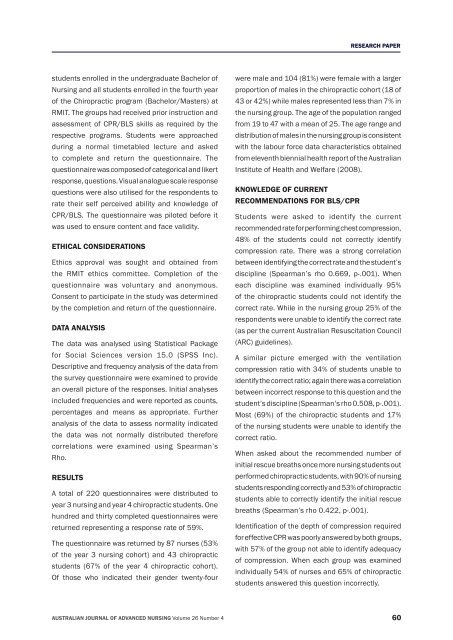australian journal of advanced nursing
australian journal of advanced nursing
australian journal of advanced nursing
You also want an ePaper? Increase the reach of your titles
YUMPU automatically turns print PDFs into web optimized ePapers that Google loves.
students enrolled in the undergraduate Bachelor <strong>of</strong><br />
Nursing and all students enrolled in the fourth year<br />
<strong>of</strong> the Chiropractic program (Bachelor/Masters) at<br />
RMIT. The groups had received prior instruction and<br />
assessment <strong>of</strong> CPR/BLS skills as required by the<br />
respective programs. Students were approached<br />
during a normal timetabled lecture and asked<br />
to complete and return the questionnaire. The<br />
questionnaire was composed <strong>of</strong> categorical and likert<br />
response, questions. Visual analogue scale response<br />
questions were also utilised for the respondents to<br />
rate their self perceived ability and knowledge <strong>of</strong><br />
CPR/BLS. The questionnaire was piloted before it<br />
was used to ensure content and face validity.<br />
ETHICAL CONSIDERATIONS<br />
Ethics approval was sought and obtained from<br />
the RMIT ethics committee. Completion <strong>of</strong> the<br />
questionnaire was voluntary and anonymous.<br />
Consent to participate in the study was determined<br />
by the completion and return <strong>of</strong> the questionnaire.<br />
DATA ANALYSIS<br />
The data was analysed using Statistical Package<br />
for Social Sciences version 15.0 (SPSS Inc).<br />
Descriptive and frequency analysis <strong>of</strong> the data from<br />
the survey questionnaire were examined to provide<br />
an overall picture <strong>of</strong> the responses. Initial analyses<br />
included frequencies and were reported as counts,<br />
percentages and means as appropriate. Further<br />
analysis <strong>of</strong> the data to assess normality indicated<br />
the data was not normally distributed therefore<br />
correlations were examined using Spearman’s<br />
Rho.<br />
RESULTS<br />
A total <strong>of</strong> 220 questionnaires were distributed to<br />
year 3 <strong>nursing</strong> and year 4 chiropractic students. One<br />
hundred and thirty completed questionnaires were<br />
returned representing a response rate <strong>of</strong> 59%.<br />
The questionnaire was returned by 87 nurses (53%<br />
<strong>of</strong> the year 3 <strong>nursing</strong> cohort) and 43 chiropractic<br />
students (67% <strong>of</strong> the year 4 chiropractic cohort).<br />
Of those who indicated their gender twenty‑four<br />
RESEARCH PAPER<br />
were male and 104 (81%) were female with a larger<br />
proportion <strong>of</strong> males in the chiropractic cohort (18 <strong>of</strong><br />
43 or 42%) while males represented less than 7% in<br />
the <strong>nursing</strong> group. The age <strong>of</strong> the population ranged<br />
from 19 to 47 with a mean <strong>of</strong> 25. The age range and<br />
distribution <strong>of</strong> males in the <strong>nursing</strong> group is consistent<br />
with the labour force data characteristics obtained<br />
from eleventh biennial health report <strong>of</strong> the Australian<br />
Institute <strong>of</strong> Health and Welfare (2008).<br />
KNOWLEDGE OF CURRENT<br />
RECOMMENDATIONS FOR BLS/CPR<br />
Students were asked to identify the current<br />
recommended rate for performing chest compression,<br />
48% <strong>of</strong> the students could not correctly identify<br />
compression rate. There was a strong correlation<br />
between identifying the correct rate and the student’s<br />
discipline (Spearman’s rho 0.669, p‑.001). When<br />
each discipline was examined individually 95%<br />
<strong>of</strong> the chiropractic students could not identify the<br />
correct rate. While in the <strong>nursing</strong> group 25% <strong>of</strong> the<br />
respondents were unable to identify the correct rate<br />
(as per the current Australian Resuscitation Council<br />
(ARC) guidelines).<br />
A similar picture emerged with the ventilation<br />
compression ratio with 34% <strong>of</strong> students unable to<br />
identify the correct ratio; again there was a correlation<br />
between incorrect response to this question and the<br />
student’s discipline (Spearman’s rho 0.508, p‑.001).<br />
Most (69%) <strong>of</strong> the chiropractic students and 17%<br />
<strong>of</strong> the <strong>nursing</strong> students were unable to identify the<br />
correct ratio.<br />
When asked about the recommended number <strong>of</strong><br />
initial rescue breaths once more <strong>nursing</strong> students out<br />
performed chiropractic students, with 90% <strong>of</strong> <strong>nursing</strong><br />
studentsrespondingcorrectlyand53%<strong>of</strong>chiropractic<br />
students able to correctly identify the initial rescue<br />
breaths (Spearman’s rho 0.422, p‑.001).<br />
Identification <strong>of</strong> the depth <strong>of</strong> compression required<br />
for effective CPR was poorly answered by both groups,<br />
with 57% <strong>of</strong> the group not able to identify adequacy<br />
<strong>of</strong> compression. When each group was examined<br />
individually 54% <strong>of</strong> nurses and 65% <strong>of</strong> chiropractic<br />
students answered this question incorrectly.<br />
AUSTRALIAN JOURNAL OF ADVANCED NURSING Volume 26 Number 4 60

















